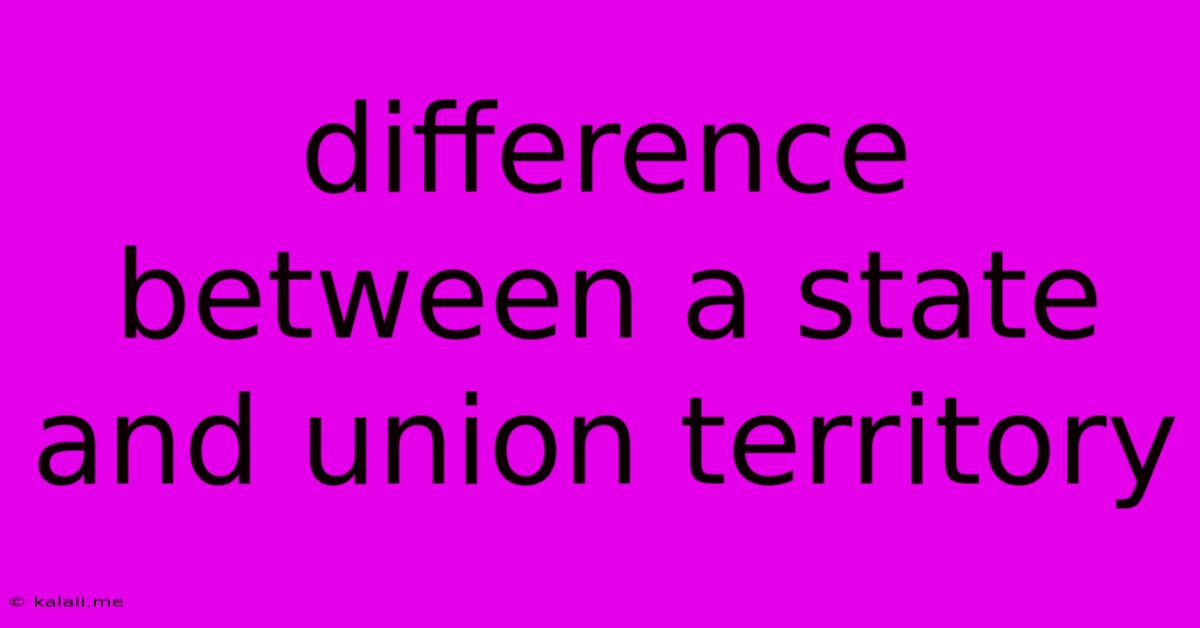Difference Between A State And Union Territory
Kalali
Jun 15, 2025 · 3 min read

Table of Contents
The Key Differences Between a State and a Union Territory in India
India's diverse political landscape comprises states and union territories, each with distinct constitutional structures and administrative powers. Understanding the differences between these two crucial components is vital for comprehending the nation's governance. This article delves into the core distinctions, clarifying the nuances of their legislative and administrative autonomy.
What is a State?
A state in India is a first-order administrative division, enjoying a significant degree of autonomy. States possess their own elected governments, comprising a legislative assembly (Vidhan Sabha) and a council of ministers headed by a Chief Minister. The Governor, appointed by the President, acts as the head of the state, primarily representing the central government. States have their own legislative powers, allowing them to create and implement laws specific to their needs within the framework of the Indian Constitution. However, their legislative powers are subject to the overriding authority of the Parliament. Key features include:
- Elected Government: States have a democratically elected government responsible for the welfare and governance of the state's citizens.
- Legislative Assembly: Each state, barring some exceptions, possesses a legislative assembly with the power to create and amend laws within its jurisdiction.
- Chief Minister: The leader of the majority party in the assembly, the Chief Minister heads the state government.
- Governor: A nominated head of state, the Governor primarily acts as a representative of the central government.
- Greater Autonomy: States have greater legislative and administrative autonomy compared to Union Territories.
What is a Union Territory?
A union territory, in contrast, is directly governed by the central government in New Delhi. Unlike states, they don't have the same level of self-governance. The President of India appoints an administrator, often called a Lieutenant Governor or Administrator, to govern the union territory. Union territories have limited legislative powers, typically delegated by the Parliament. Some union territories have their own legislative assemblies, while others are directly administered by the central government. The key characteristics include:
- Direct Central Rule: The central government directly governs union territories, with limited or no elected legislative assemblies.
- Administrator/Lieutenant Governor: The head of administration, appointed by the President, wields significant power.
- Limited Legislative Powers: Legislative powers are significantly restricted and primarily vested in the Parliament.
- Less Autonomy: Union territories have substantially less autonomy compared to states.
Key Differences Summarized:
| Feature | State | Union Territory |
|---|---|---|
| Governance | Elected state government | Direct rule by central government |
| Head of State | Governor (appointed by President) | Administrator/Lieutenant Governor (appointed by President) |
| Legislative Power | Significant autonomy (subject to Parliament) | Limited or none, delegated by Parliament |
| Legislative Assembly | Usually present | Present in some, absent in others |
| Administrative Autonomy | Greater | Lesser |
Why the Distinction Matters:
This fundamental difference in governance structures impacts various aspects, including policy implementation, resource allocation, and citizen participation in governance. States enjoy a higher level of self-determination, allowing for tailored policies addressing their unique needs and challenges. Union territories, on the other hand, are more closely aligned with national priorities and policies.
This distinction reflects the complex federal structure of India, balancing the need for national unity with the importance of regional autonomy. The differences between states and union territories highlight the diverse administrative framework that governs this vast and varied nation. Understanding these nuances is crucial for anyone seeking a comprehensive understanding of India's political system.
Latest Posts
Latest Posts
-
What Is A Major Element Found In Bones
Jun 15, 2025
-
What Is The Storage Form Of Glucose In Plants
Jun 15, 2025
-
Which Is Heavier Kilograms Or Pounds
Jun 15, 2025
-
Identify The True And False Statements About Survey Research
Jun 15, 2025
-
Chromosomes Are Primarily Composed Of Dna And
Jun 15, 2025
Related Post
Thank you for visiting our website which covers about Difference Between A State And Union Territory . We hope the information provided has been useful to you. Feel free to contact us if you have any questions or need further assistance. See you next time and don't miss to bookmark.